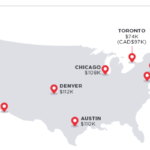News Analysis/Feature by Andrew Lam
by Andrew Lam, Pacific News Service
August 1, 2003 – Vietnamese Americans are known for their passionate protests against the Communists ruling their homeland, but they are not known for militant responses to issues they face in this country. The recent police shooting of a Vietnamese housewife in San Jose, Calif., may be changing all that.
San Jose is home to the second-largest resettlement of Vietnamese in the world. On July 22, 2003, a Vietnamese woman named Cau Bich Thi Tran was shot and killed by the police in her own kitchen, after she allegedly threatened them with a vegetable peeler that resembled a cleaver.
The Vietnamese community flew into an uproar, unleashing a series of actions that showed an extraordinary flexing of collective muscle. A demonstration confronted the San Jose city hall within a day. A frenzied letter-writing campaign targeted local politicians. A vigil of 400 people, including singers, clergymen and non-Vietnamese supporters quickly materialized.
All the while, Vietnamese newspapers, radio programs and Internet chat rooms buzzed with information to keep every Vietnamese in the United States abreast of the tragedy.
The result of these actions have been staggering. Money poured in from various Vietnamese communities around the world to help the victim’s family. San Jose’s mayor met with community leaders and the police chief promised a full investigation before moving to a new job in another city. Police representatives apologized to the Vietnamese community on Vietnamese radio programs. The FBI made a preliminary inquiry, and the Santa Clara District Attorney’s Office announced an unusual step to open a grand jury and to publicly air the facts of the case.
It’s a far cry from the usual protests for which Vietnamese are known. In 1999, for example, more than 20,000 Vietnamese Americans besieged a video shop in Southern California’s Little Saigon because the owner had put up a picture of Ho Chi Minh. The thrust of such activism has been symbolic: petitions to local governments to recognize the South Vietnamese flag as the official flag of Vietnamese communities here; fundraisers to build a Vietnam war memorial in Orange County. Only now have Vietnamese Americans raised their voices over a domestic issue.
| If there is a history of in-fighting and dispute in the community, it was not evident this time. No factions, no generation gaps: The tragedy united us in a way that hasn’t happened before. |
Madison Nguyen, board member of the Franklin-McKinley School District in Santa Clara who spearheaded the recent protests against the police shooting, says, “The tragedy has definitely brought the Vietnamese community together. With the rally that I helped organize, it only took less than 24 hours to get more than 200 people to show up at City Hall.”
For the first time since she came to San Jose, Nguyen adds, an event caused “all Vietnamese to come together and fight for the same cause — to request that the San Jose police department conduct a thorough and complete investigation of the incident.”
“If there is a history of in-fighting and dispute within the Vietnamese community, it was not evident this time,” observes Quynh Thi, publisher and editor of Vietnam Daily, one of three daily Vietnamese-language papers in San Jose. “This time there’s no factions, no generation gaps. The tragedy unites our community in a way that hasn’t happened before.”
For many young Vietnamese in America, who are too young to remember Vietnam and the war and who feel a psychological distance from the anti-communist passion of the older generation, there is now genuine surprise and pride.
Tony, a 22-year-old recent college graduate in San Francisco who did not want his last name used, observes: “I never identified with flag-waving. In fact, I was embarrassed by it. But I certainly feel that the community is doing something right. Our lives are here and now, and we should focus on fighting for fair treatment here. I’m totally down with that.”
Tony may be embarrassed by his parents’ flag-waving, but it is precisely those years of anti-communist activism that have created a large network — radio programs, Web sites, in-language newspapers and an army of volunteer protestors — that can rally large gatherings at a moment’s notice.
What’s more, says Phillip Nguyen, director of the Southeast Asian center, the Vietnamese community is beginning to find new ways to focus its energy. “I think that the San Jose police have this belief that Vietnamese tend to organize a protest only when it comes to homeland politics. This may explain their reactions during the first 48 hours, when they tried to overpower the community they perceive as silent and invisible on issues related to their rights here in the United States. Well, they are wrong.”
In the neighborhood where Bich Cau Tran was killed, a largely Hispanic working class neighborhood, Marcelino Perez, 22, a Mexican American, says that he is amazed by the unity of the Vietnamese community. “That’s why Vietnamese are taken seriously. Mexicans are not. We experience police abuse but we don’t have the same clout to demand for change.”
Rocky Hernandez, 20, who also lives in the neighborhood, put it more plainly: “You don’t mess with Vietnamese in Silicon Valley. They stick together. Everybody knows that.”
The Vietnamese community is relatively young community as far as ethnic communities go — less than 30 years old. Whether it will mature politically depends on how well it sticks together despite generation gaps and political differences, and perhaps more importantly, how it finds new ways to translate nostalgic passions into tangible political clout.










